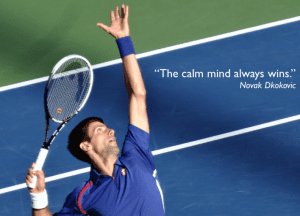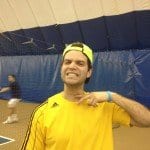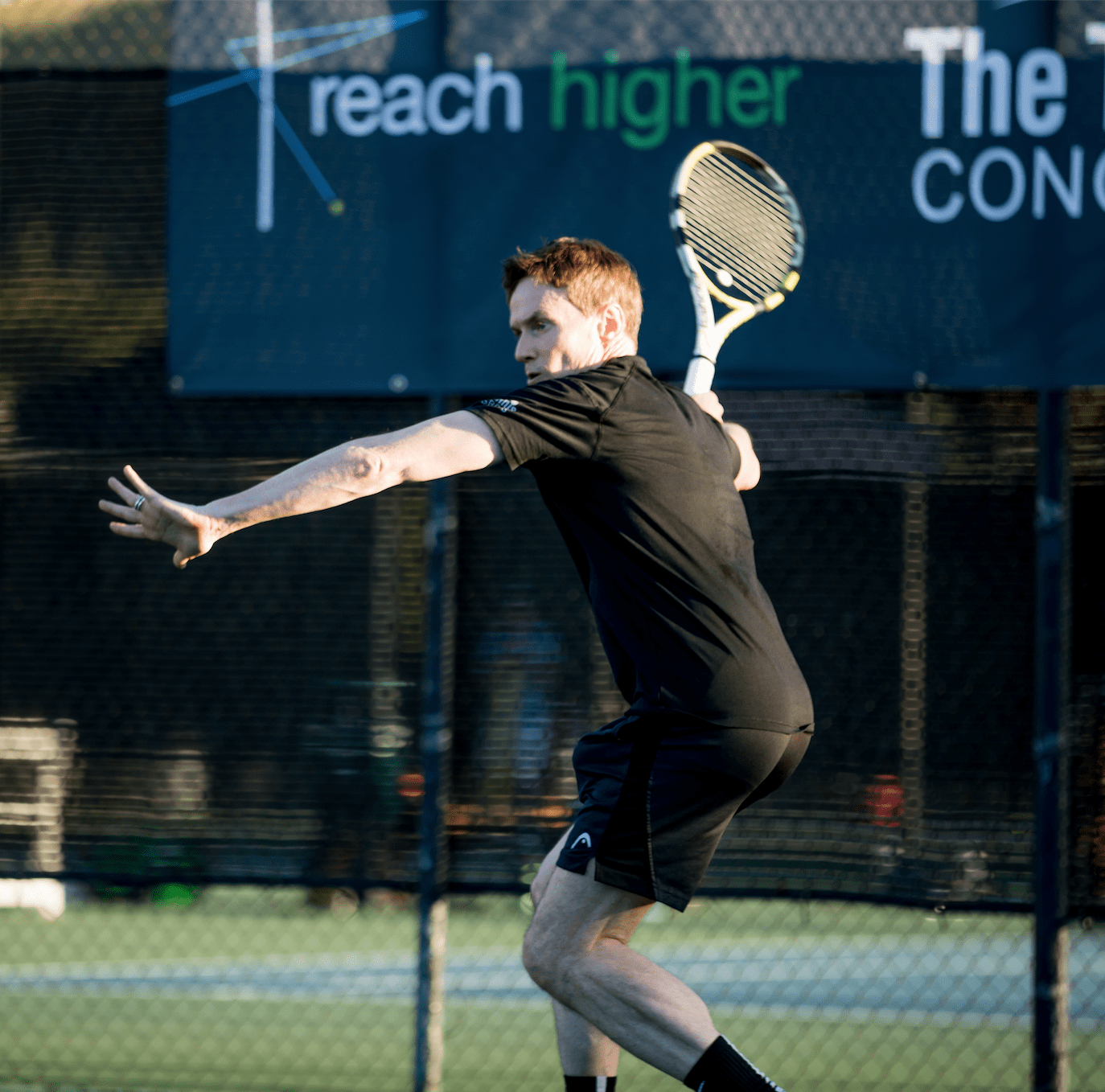Grace Under Pressure: 10 Tips to Combat Tightness
A few weeks ago I got some hard-to-hear but truly game-changing advice while training over the weekend at “Total Tennis,” a tennis camp in upstate NY that’s become my home away from home.
I had just finished a fast-paced and inspiring morning group session with two incredible pros: Saif Syed and Devarshi Mitra (aka “Bubla”). It was about my 10th weekend working with Saif, who I call my tennis “Yoda” because of the remarkable way he brings both calm, quiet energy and intensity to every training session and his uncanny ability to impart just the right words of wisdom (with a dash of humor) at precisely the right moment.
Walking off the court to lunch, I felt good: I had hit pretty well alongside several much-better players and was drenched after working my tail off for 3 hours. Then Saif called me over and signaled to Bubla to join us. In his typically kind, warm and gentle way, Saif said something like this:
“Great work, looking good, P.J. Your technique has improved big time over the past 6 months. You’re hitting the ball really well. You’re making better choices. You’re getting to balls a lot of other people can’t. But… if we’re going to get you to the next level we need to focus on something else: it’s time to focus on getting you to play more gracefully…more fluidly, more relaxed… That’s what you’re going to need to get to 4.5-level tennis.”
Bubla nodded. They both agreed I was generally working harder than I needed to… muscling the ball too much… playing too tight and tense during pressure situations or when I got tired. As a result of physical tightness, I was counterintuitively losing potential power from my strokes and serves; as a result of mental tenseness, I was missing shots that should have been winners: I was rushing too often, running through too many balls, forgetting basic things like simply “watching the ball” during pivotal moments.
For the rest of the weekend, I committed to change my focus from “perfecting technique” to getting more graceful and loose on the court. And Saif and Bubla gave some invaluable, practical advice that really helped.
By the end of the following day, my brain and body were telling me I was really onto something important. I noticed three really good things happening as I reduced physical and mental tension:
- More Power. Over the past few months I’ve been learning how upper-body looseness can unleash new power on serve–but this was the first time I truly began to feel how much more power I could get on groundstrokes by playing looser. My personal trainer Jay Gallegos (a student of Bruce Lee) once explained how this works by simply saying: “You can’t crack a stiff whip.” Slovenian coach Tomaz Mencinger gives one of the best explanations I’ve seen in this article on why power in tennis is achieved through relaxation and speed, not strength and tension.
 Sharpened Awareness. The more I eliminated tension in the body, the more I was able to reduce tension in my head– always a good thing in tennis. Suddenly I had greater presence of mind to accurately judge the ball, anticipate what my opponent was about to do, and make better split-second decisions. I found myself observing, watching, listening more instead of panicking. I also felt more physically “centered” and aware of my body’s core–which I knew was helping to insulate my body from injury as I sprinted and lunged for tough shots. And whenever things started going wrong with technique– serves into the net, forehands going long, etc– my calmer mind enabled me to simply notice (with less judgment) what was happening and make the minor self-corrections needed.
Sharpened Awareness. The more I eliminated tension in the body, the more I was able to reduce tension in my head– always a good thing in tennis. Suddenly I had greater presence of mind to accurately judge the ball, anticipate what my opponent was about to do, and make better split-second decisions. I found myself observing, watching, listening more instead of panicking. I also felt more physically “centered” and aware of my body’s core–which I knew was helping to insulate my body from injury as I sprinted and lunged for tough shots. And whenever things started going wrong with technique– serves into the net, forehands going long, etc– my calmer mind enabled me to simply notice (with less judgment) what was happening and make the minor self-corrections needed.- “More Time”. My ability to calm my body and mind started creating more moments of being “in the zone.” Time slowed down. The ball grew to the size of a softball. I would have moments like in “The Matrix” where I felt confident I had plenty of time to react… and my body felt more nimble, adaptive, and responsive to all kinds of different situations.
Of course getting to that state on a regular basis is easier said than done. It’s going to be a long journey before it becomes the norm. But I have noticed certain tactics helping more than others to help me get there. Here are the ten tactics that seem to be helping me the most:
1.Forget technique during matches
Saif Syed once told me before a match to think only about three things: “Watch the ball, Move your feet, Trust your swing.” Other coaches have, in different ways, also underscored the importance of letting go of a focus on perfect technique during matches. Improving my technique will be a lifelong pursuit and there are plenty of good times to do it: match time is not one of them.
2. Breathe IN as the ball approaches.
Bubla urged me also to consciously inhale as the ball is coming toward me or as I’m tossing during a serve. It’s been a huge, huge help to me in focusing my mind while relaxing my shoulders and arm.
3. Watch the fuzz (or the seams) of the ball.
Timothy Gallwey in his timeless Inner Game of Tennis recommends this tactic, and it works wonders whenever I deploy it. Time slows down and the ball gets bigger.
4. “Behave your way into the zone.”
This is one of many gems of practical advice from the brilliant player, coach and sports psychologist Jeff Greenwald. Jeff encourages players to “Act like you belong” and “behave your way into the zone” through body language, posture, and attitude. Think of the way Djokovic looks before and during every point: head high, chin up, shoulders relaxed and back, athletic position… It all says “Bring it on.” When I start feeling insecure or discouraged (and therefore tight), I at least try to put on my game face and start acting more confident. Pretty soon, my body accepts this as “reality” and no longer acting.
5. Visualize the outcomes:
Many great coaches recommend visualizing specific outcomes you want during matches rather than trying to use your intellect to achieve them. Imagining Roger Federer’s effortless volleys usually helps me far more than over-analyzing my technical shortcomings. Visualizing a relaxed service motion by Djokovic and imagining the ball being placed exactly where I want it to go works better than telling myself the 5 things I need to do to achieve the perfect serve. Channeling the feeling from a recent moment of playing “in the zone” by recalling certain images or sounds is way more helpful than telling myself to “Relax!”
6. Think “Neutralize” (not “defend against”) tough balls.
I had a big epiphany moment when Bubla urged us to think about handing tough balls from opponents in an offensive way by “neutralizing” them. It was such an empowering concept: instead of panicking about a tough ball coming my way and getting my mind in defensive mode, the idea of neutralizing the ball made me focus on the opportunity ahead with the next ball.
7. Think Mohammed Ali to keep your feet moving. (Or Gangham Style… or whatever works!).
When focusing on upper-body relaxation, I’ve had the unfortunate side effect of overly relaxing my lower body and feet, which need to stay active and energized at all times. Visualizing Mohammed Ali– light as a butterfly on his feet– has been one of the most powerful ways to find the right combination of lower body engagement with upper body “grace.”
8. Use rituals.
Jeff Salzenstein recently published a great post and video on the importance of “rituals” to maintain (or rediscover) a calm state between points. My fellow tennis blogger Kim (“Tennis Fixation”) shares the rituals she uses when serving. It doesn’t matter what the rituals are, so long as they help clear and re-focus the mind. For me, incorporating good breathing into my rituals between points has been hugely important. I also use rituals to remind me of how grateful I am for many great people and things in my life: doing so during stressful moments helps me put things in proper perspective and calm me down.
9.  Smile.
Smile.
This is one of Jeff Greenwald’s secret weapons, and now it’s one of mine. When my head getting tense and my body starts clenching up, I turn to the wall, take a breath, and smile. I often think of my hilarious teammate Ricardo who, whenever we’re about to play a match, is prone to (jokingly) making a gesture to indicate I’m about to get my throat slit. This always makes me laugh out loud and immediately loosens me up.
10. Add meditation and yoga to off-court training regimen.
It goes without saying that if we want to move more fluidly and efficiently on court we need to invest time in tennis-specific strength and flexibility conditioning (here’s some background on how I approach off-court training). But I’ve also discovered the benefits to my game that come from adding in some yoga and meditation to my routine. Yoga helps develop good physical and mental habits (proper breathing, quieting the mind, staying “present”) that can be invaluable during stressful situations on court. And even just a few minutes a day of meditation can yield big dividends: thanks to a fellow player Kirk (a 5.0), I recently started a “21-day meditation challenge” (only 12-15 minutes a day) that has already produced some powerful benefits both on-court and in daily life and work.
There is perhaps no better argument for adding more “grace” to one’s tennis game than the example of Roger Federer. The Fed’s seemingly effortless economy of movement and habitual calmness of mind have given him deceptively powerful strokes and serve, a magician’s capacity to perform the impossible, and the ability to stay injury-free. Not to mention how beautiful all that is to watch. As the late David Foster Wallace put it in his must-read ode to The Fed, “Federer as Religious Experience“:
“A top athlete’s beauty is next to impossible to describe directly. Or to evoke. Federer’s forehand is a great liquid whip, his backhand a one-hander that he can drive flat, load with topspin, or slice — the slice with such snap that the ball turns shapes in the air and skids on the grass to maybe ankle height. His serve has world-class pace and a degree of placement and variety no one else comes close to; the service motion is lithe and uneccentric, distinctive (on TV) only in a certain eel-like all-body snap at the moment of impact. His anticipation and court sense are otherworldly, and his footwork is the best in the game — as a child, he was also a soccer prodigy. All this is true, and yet none of it really explains anything or evokes the experience of watching this man play. Of witnessing, firsthand, the beauty and genius of his game. You more have to come at the aesthetic stuff obliquely, to talk around it, or — as Aquinas did with his own ineffable subject — to try to define it in terms of what it is not.”
Feel Free to reach out to me directly at roadto45@gmail.com and be sure to follow me on social media!





Thanks for the mention! I have taken up Bikram yoga recently and have heard Andy Murray and Laura Robson are also into it. It has definitely made me “looser” overall and I’m hoping it will help my tennis. Great piece and tons of good tips.
Kim, my pleasure! Thanks for all your great posts and insights on your “TennisFixation.com” blog. P.J.
[…] things like simply “watching the ball” during pivotal moments. … See original here: Grace Under Pressure: 10 Tips to Combat Tightness – The Road to … ← Craig Hickman's Tennis Blog: Australian Open 2010 Men's Final […]